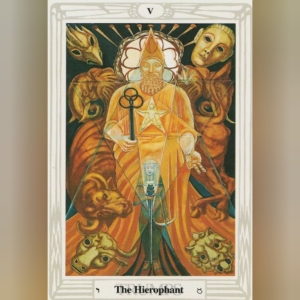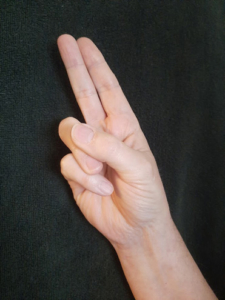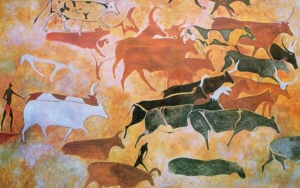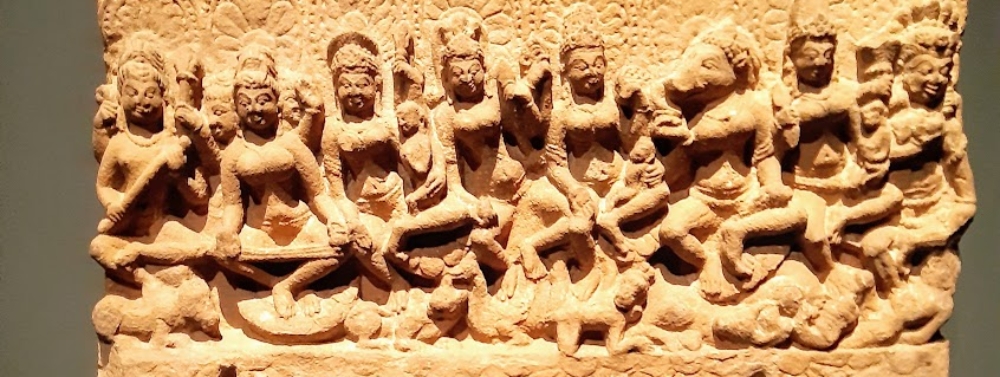
responsibility of embodying Demeter and Persephone respectively in ritual.
From the above, we can understand that the hierophant is a top religious
figure like the Pope, or the chief Rabbi, whose job was to be a conductor,
a channel, funnel, or mediator between the gods and the people. In this
particular card, focusing only on the hidden symbolism, the hierophant
is the representation of the goddess Nuit.
Nuit is the embodiment of infinite space and also the mother of all stars
— for it’s known that “Every man and every woman is a star”(Liber AL,
chapter 1, verse 3). With this in mind, she is where each star returns.
Additionally, she is also the divine law which must be given to those who
follow the hierophant.
“Let the woman be girt with a sword before me” (Liber AL, chapter 3,
verse 11) At the front of the card, before the hierophant, we can see the
woman girt with a sword. The Book of Thoth speaks of the ‘Scarlet Woman’
as an emblem of the new era; she stands for a transformation away from
her traditional image as a housewife or accessory to her male partner,
instead embracing her identity while searching for autonomy and equality.
We can see how all of this manifests in the MeToo movement of our
days.
“The woman is the priestess; in her reposes the mystery. She is
the mother, brooding yet tender; the lover, at once passionate
and aloof; the wife, revered and cherished. She is the witch
woman.” (Freedom is a Two-edged Sword, Jack Parsons)
The deeper we look into the hidden symbolism and meaning of this
mysterious woman, the clearer it becomes that she can be Nuit herself,
guarding the divine law. The law is simple and clear and the hierophant’s
job is to pass it to their congregation:
“Love is the law, love under will”
Or in our words:
“Love and do what you will.”
“The symbolism of the Wand is peculiar” – Solve et Coagula (Aleister
Crowley, The Book of Thoth). Crowley describes the three interlaced rings
of the wand, as a “representative of the three Aeons of Isis, Osiris and
Horus”. However, on a closer look, we see that the hierophant holding
the wand with its three rings aspiring upward, in his right hand (solve).
As a Setian/Typhonian, I couldn’t help the thought that the three
interlaced rings would be much more comfortable in the right hand of
destruction (solve) as a representative of Set, Osiris & Ra.
Set and Osiris are both Ra’s grandsons and make a sacred triad. Both
brothers have to sacrifice themselves for the continuation of Ra — of
life — Osiris being killed by his brother Set, and Set killing his brother
and becoming the ‘outcast’ God.
The demonstration of the cycle of life through destruction and creation
is continued with the symbolism of the hierophant’s left hand. His left
hand (coagula) is pointing downward in the Shamak mudra hand position.
I must admit that this never occurred to me before, but once I became
aware of it, I could not un-see it. The Shamak mudra, also called the
kidney mudra, is the perfect hand position to deliver the message of
Solve et Coagula (destruction and creation). At the start, I had difficulty
understanding how the Shamak mudra was linked with Solve et Coagula
and its role in occult symbology in particular for the hierophant and his
wand.

Shamak mudra
The main function of the kidneys is to cleanse the blood of toxins and
transform the waste into urine. The hierophant’s right hand in the Shamak
mudra, suggests that before we can coagulate, we must be cleansed and
purified of all toxins. Only then can we coagulate into our new and
transformed selves.
“The Throne of the Hierophant is surrounded by elephants, which are
of the nature of Taurus; and he is actually seated upon a bull.” (Aleister
Crowley, The Book of Thoth). At first sight, the card seems to resonate
with the symbolism of the zodiac sign Taurus, which is an earth sign.
symbolizes the earth element at its most balanced and strong. If we look
at the symbolism of the bull from the Setian perspective, it takes us back
to the prehistoric ‘cattle cult’, which is probably one of the world’s oldest.
Egyptian male deities often have a bull representation. Set is most notably
known for the ‘Bull of Ombos’. It is likely that this bull cult evolved out
of the Cattle cult, which was centered around the Heavenly Cow/Hathor,
who symbolizes the feminine aspect of this tradition.
The bull is associated with male fertility and strength, as seen in energy,
stamina, and endurance. Worshipped in antiquity, it is also linked to the
zodiac sign Taurus, which is associated with spring in the agricultural
calendar as a symbol of renewal, prosperity, and abundance. However,
this powerful creature can be equally connected to hard-headedness,

Cave paintings from the Tassili n’Ajjer mountains (photo courtesy of wiki commons wikimedia.org)
accept a sacrificial offering as an act of reverence. It is easy to believe
that religious reverence for the bull’s cult has been forgotten in modern
times, yet our practices today have still taken on a new form – the dairy
and meat industry.
Just to remind you, a hierophant is a person who brings religious
congregants into the presence of that which is deemed holy. As such, a
hierophant interprets sacred mysteries and arcane principles. In this card,
the hierophant symbolizes the link to the secret of the rhythm of time
and the ancient practice of the worship of the bull.
guarded by Nuit/Nwt and delivered by the hierophant.
